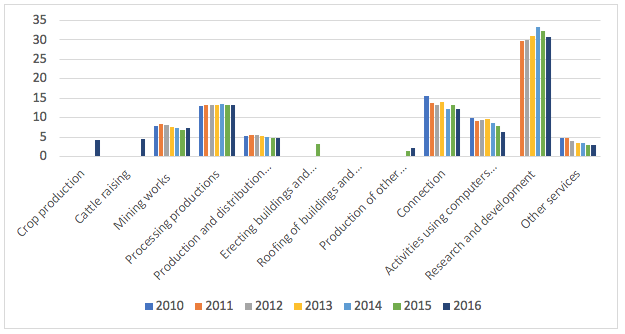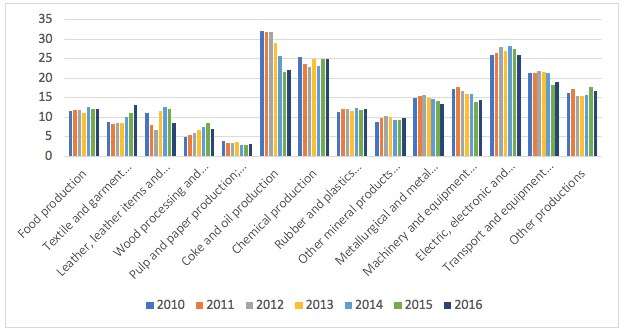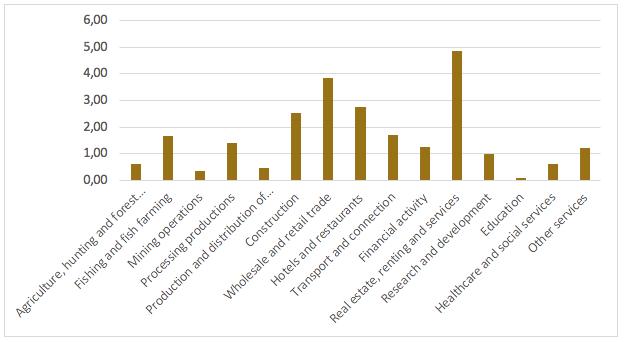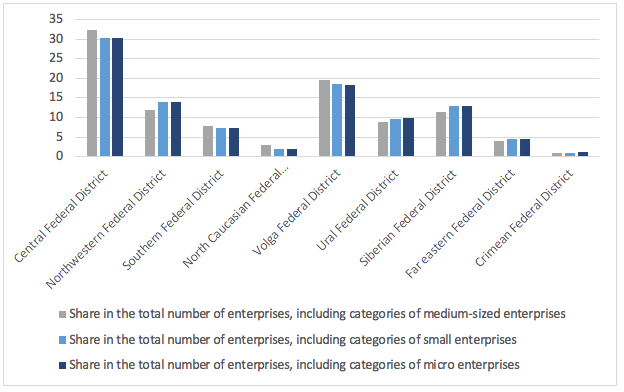

 Vol. 39 (Nº36) Year 2018. Page 17
Vol. 39 (Nº36) Year 2018. Page 17
USTINOVA Olga 1
Received: 27/03/2018 • Approved: 11/05/2018
ABSTRACT: The article touches upon the subjects of competitiveness management of Russian companies in the conditions of innovative development. The work provides an analysis of the main estimates within groups of objects of intellectual property, the dynamics of their use by Russian economic entities; considers the change in the innovation activity of Russian organizations in terms of types of economic activity, where the manufacturing industries are presented in more detail; provides the analysis of the level of concentration of small and medium-sized enterprises in the regional aspect, as well as according of their economic activities. |
RESUMEN: El artículo aborda los temas de la gestión de la competitividad de las empresas rusas en las condiciones de desarrollo innovador. El trabajo proporciona un análisis de las principales estimaciones dentro de los grupos de objetos de propiedad intelectual, la dinámica de su uso por las entidades económicas rusas; considera el cambio en la actividad de innovación de las organizaciones rusas en términos de tipos de actividad económica, donde las industrias manufactureras se presentan con más detalle; proporciona el análisis del nivel de concentración de las pequeñas y medianas empresas en el aspecto regional, así como de acuerdo con sus actividades económicas. |
In the current complicated economic conditions, the market orientation of Russian economy causes a change in views on the organizational management of economic entities and predetermines the need to develop new approaches to the management of competitiveness. Among the main factors characterizing the competitive positions of any organization, industry and the country as a whole, it is worthwhile highlighting the quality of management, the effectiveness of the financial system, the state and development of intellectual capital, openness and sensitivity to innovation. The entities that take part in the competitive struggle partly proceed with the global development strategy of national economy, while the state appears to be the most important reference point for their activities. It is important to note that the necessary competitive conditions are provided by the state through the improvement of the antimonopoly legislation regulating relations in this sphere. However, creation of conditions for internal competitiveness also implies the use of not only methods of price-based competitiveness in the strategy of domestic companies, but the application of modern technologies, achievement of higher quality products and services, as well as formation, development and effective use of intellectual capital.
In this work, we analyze the main volume estimates within groups of intellectual property objects, their use in the regional aspect, consider the dynamics of innovative activity of organizations, and analyze the level of concentration of small and medium-sized enterprises by types of economic activity.
The issues of competitiveness management are widely reflected in the works of well-known scientists. Studies of R. Acoff (1985), I. Ansoff (1999), J. Collins (2004), M. Porter (2016), F. Hayek (2016) and others contributed to the development of the problem of competitiveness as the most important factor of economic development. Various aspects of the analysis and assessment of innovation, competitiveness and intellectual capital are stated in the works of domestic scientists and practitioners: O.S. Vikhansky (2015), O.V. Motovilova (2014), R.A. Fatkhutdinova (2016), as well as foreign scientists, including F. Kotler (2017), J. Ruus (2010), H. Itami (1991), J. Schumpeter (1934), T. Stewart (1997) and others.
Theoretical and methodological basis was the fundamental concepts presented in classical and modern works of scientists and economists, the works of domestic and foreign researchers. The information base of the work is taken from Russian and international legislation, statistics, results reflected in the works of domestic and foreign authors. The research has been made with the use of general scientific methods of cognition based on system-logical and interdisciplinary approaches. Processing and generalization of information were carried out by grouping, empirical, statistical, graphical and other methods.
The most important factor contributing to the competitiveness of Russian companies is innovative development that means building up the interrelationships of scientific, technical, industrial, financial and social activities. With regard to Russian companies, it is important to emphasize the terms of choosing not only particular directions of innovative development, but also the comprehension of conceptual and methodological approaches to measuring the impact of innovative developments and products on their competitiveness. Practice shows that regardless of which position the economic entity originally occupied, what market share it owns, the representative of a large, medium or small business it is, what its legal form is, etc., the implemented innovation can lead to a significant growth of profits. It follows that at the present stage of development of market relations in Russia, the innovative component is becoming one of the fundamental factors in making the competitiveness of both industries and companies. Also, under conditions of globalization, that covers new spheres of activity, Russian organizations have to compete more actively with foreign companies that have certain advantages, including technical level and quality of products. International ratings and statistics are the evidence that the countries with limited natural resources and a small area are leaders and occupy leading positions upon certain indicators. In terms of GDP of 2017, the USA, China, Japan, Germany, Great Britain, France are traditionally in the lead and Russia ranks 13th. Along with this, in terms of GDP per capita, Luxembourg, Switzerland, Norway and Qatar take the lead, while Russia is only in the seventieth. The situation in Russia under the economic crisis and existing sanctions requires close attention to the development of intellectual potential and providing its effective use, as it becomes a key source of economic growth, and its scale and quality determine the basic parameters of innovative development to a large and increasing extent.
Official data of the Federal State Statistics Service of Russia on the innovative activity of organizations [11] indicates an increasing share of innovative goods, works, services in the total volume produced (8.4% according to 2015). Provided that, the service sector takes higher share of innovative component (12.9%) than industrial enterprises (7.9%). According to the Federal Service of Intellectual Property, the dynamics of volume indicators for trademarks in 2016 in relation to 2014 shows increase of 30%. Along with this, the dynamics of volume indicators for inventions and useful models has a negative value (Table 1), except industrial samples [2].
Table 1
Analysis of volume indicators by groups of objects of intellectual property for 2014-2016.
Name of groups of objects of intellectual property |
2014 |
2015 |
2016 |
2014 / 2016 |
Trademarks |
42 328 |
43 067 |
55 215 |
+30% |
Computer programs, databases and topologies of integrated micro schemes |
15 148 |
15 691 |
15 858 |
+5% |
Inventions |
33 950 |
34 706 |
33 536 |
-1% |
Useful models |
13 080 |
9 008 |
8 875 |
-32% |
Industrial samples |
3 742 |
5 459 |
4 455 |
+19% |
Dynamics of use of intellectual property objects in the context of federal districts of the Russian Federation for 2016 shows that not all regions reach average values. The leaders are Central and Volga districts with 43.2% and 25.7% for all types of intellectual property used. The Southern, North Caucasus and Far Eastern Federal Districts use the least amount of such objects (3.0%, 0.8%, 0.9%, respectively). The present state requires further analysis of causes of the uneven distribution and the use of intellectual property in the regional aspect. Among the common features of the current stage of innovative development, it is worth noting the lack of effectively functioning innovation centers in most regions of the Russian Federation, the lack of financing of such projects, and the lack of control while implementing state programs aimed at its development. For example, according to the report of the Accounting Chamber of the Russian Federation in relation to the state program "Development of industry and improving its competitiveness" for the year 2016, thirteen performance targets (indicators) out of nineteen do not provide planned values, as a result it is not possible to control accomplishments of performance targets and goals. Moreover, the analysis of accomplishment of the targets of this state program, in particular, the indicator "Innovative activity of industrial production is only 10% out of planned 50%. One of the reasons that had a negative impact was the slow pace of industrial recovery due to the economic crisis. The opinion of the Accounts Chamber of the Russian Federation on the degree of effectiveness of this state program is defined as "below average" [3].
Execution level of the indicators of another state program "Economic development and innovative economy" is 70.8%, whereas the budgetary allocations in 2016 were increased. Under the subprogram "Investment climate" target indicators were accomplished by 60%, "Development of medium and small entrepreneurship" by 75%, "Stimulation of innovations" by 75%. Moreover, the state program "Development of science and technologies" deserves high attention. According to the Ministry of Economic Development, the degree of its effectiveness is 80.5% that is defined as "below average". The Accounts Chamber of the Russian Federation also notes the absence of specified target values for twenty indicators out of twenty-eight, including subprograms as: "Development of the applied research and developments sector", "Institutional development of the research sector", "Development of inter-branch infrastructure of the research and developments sector". Results of the budget implementation on the reviewed state programs partly characterize the dynamics of the use of intellectual property in the territory of the Russian Federation (Fig. 1).
Figure 1
Dynamics of use of intellectual property objects
in the regions of the Russian Federation for 2016

Analysis of innovative activity of organizations shows its growth for 2016 by 56.6% as compared to 2010. Nevertheless, its dynamics by types of economic activity is characterized by opposite values. The highest percent certainly falls on research and development 34.6%, then processing industries 15%, and communication 13.7%. According to the official statistics [4], there are no indicators reflecting the innovative activity in installation, construction of buildings and structures (Figure 2), low values in agriculture (4.7%), and other services (3%). Insignificant growth is noted in 2015 and 2016 in the manufacture of other construction works 1.5% and 2.2% respectively.
Figure 2
Dynamics of innovative activity of organizations
by types of economic activity

Among the types of economic activity listed above, special attention should be paid to the analysis of innovative activity of organizations in manufacturing industries. The highest positions are in the production of coke and petroleum products (11.0%), chemical production (12.4%), production of electrical, electronic and optical equipment (Figure 3). However, there is a downfall in innovation activity from 2010 to 2016 for the first of these activities by 27%. It is also worth pointing its overall reduction of 5.3% for all manufacturing industries.
Figure 3
Dynamics of innovative activity of organizations
in manufacturing industries

Thus, in order to stimulate the innovative activity of economic entities it is necessary to form and develop an appropriate infrastructure throughout the Russian Federation, including information and consulting support, access to modern technologies, and so on.
Depending on the economic activity carried out, the diagram below shows an analysis of the indicator calculated as the ratio of the number of medium and small enterprises to the total labor force for 2015, which characterizes the level of their concentration in type (Fig. 4). Its highest value is in the activities related to real propery (4.84), wholesale and retail trade (3.86), and provision of hotel and restaurant services (2.74). Low indicators are noted in the activities for the extraction of minerals (0.36), in education (0.61), in the production and distribution of electricity, gas, water (0.48), in agriculture (0.63).
Figure 4
Level of concentration of small and medium-sized
companies by type of economic activity

The competitiveness management of an economic entity should be considered as a process of forming and maintaining competitive advantages while eliminating vulnerable ones. From the position of strategic management, it is focused on the making the competitive advantages and market positioning based on the effective use and development of intellectual capital.
The visible result of such development may be an increase of consumer value of the product, a reduction of production costs, a decrease of the product cost, an improvement of the product quality and obtaining its unique properties; and “invisible” results may be an increase of the level of product prestige and status and formation of a positive image of the business entity as a whole. It is worth emphasizing that the consumer notices these developments, but does not realize the very content of technological and organizational, managerial processes and other factors.
Analyzing the conditions of the competitive environment, we cannot fail to note the crucial role of the marketing component in the competitiveness management of the organization. In this regard, intellectual capital acts as an integral component of the organization's marketing strategy in managing its intangible assets. It is also worth noting the influence of environmental factors of direct and indirect impact. The first one includes the introduction of new technologies, competitors, suppliers, consumers, intermediaries. Indirect impact is manifested through strategic foresight, the use of innovative and intellectual potential, etc. Thus, while creating conditions for the formation, effective use and development of intellectual capital, economic entities are able to increase competitive advantages and take the leading positions in the market.
Figure 5
The share of medium and small enterprises in the total number of operating
companies in the context of the federal districts of the Russian Federation in 2015

The results of the analysis of medium and small enterprises operating in the territory of the Russian Federation testify to their uneven distribution in the federal districts of the Russian Federation (Figure 5) and their large concentration in the Central (30%) and Volga (18%) regions. Low indicators are in the Far Eastern (4%), North Caucasian (2%) and Crimean (1%). The conducted regression analysis confirms the dependence of the number of medium and small enterprises on the number of labor in the regions of the Russian Federation, the coefficient of determination is 0.958 or 95.8%. Also, the level of concentration of small and medium-sized companies in the regional aspect characterizes its relatively uniform distribution throughout the Russian Federation (Table 2). The leading position relates to the North-West Federal District, which is ahead of the Central and Ural regions.
Table 2
Comparative analysis of the number of small, medium-sized
enterprises and the labor force by regions for 2015
Federal District of The Russian Federation |
Number, people |
Number of small, medium-sized enterprises |
Relation of the number of medium and small enterprises to the total labor force |
Central Federal District |
21 108 173 |
446 772 |
0,02 |
Northwestern Federal District |
7 604 243 |
203 477 |
0,03 |
Southern Federal District |
7 017 089 |
107 478 |
0,02 |
North Caucasian Federal District |
4 492 285 |
29 116 |
0,01 |
Volga Federal District |
15 502 170 |
271 706 |
0,02 |
Ural Federal District |
6 508 716 |
140 444 |
0,02 |
Siberian Federal District |
9 815 533 |
188 807 |
0,02 |
Fareastern Federal District |
3 376 314 |
65 195 |
0,02 |
Crimean Federal District |
1 163 027 |
15 423 |
0,01 |
The analysis of innovative activity and the level of concentration of small and medium-sized enterprises in these aspects allows to talk about the general negative trend of innovative development and the need to immediately respond to the current state both at the level of economic entities and the Russian economy as a whole. In this regard, close attention should be paid to the full implementation of budgetary funds aimed at innovative development and increasing competitiveness. Moreover, it is necessary to strengthen control at the stage of consideration of the federal and regional budgets for the planned targets (indicators), which in the future will characterize the degree of effectiveness of the funds spent.
Summarizing the above, it can be concluded that the modern competitive environment in conditions of a dynamically developing market causes the need for continuous improvement of scientific approaches, methods and methods of competitiveness management. Herewith, the significant role of the intellectual component as a part of the resource base of economic entities and innovative development is now becoming prevailing. In this regard, in order to increase the cost potential, the companies should pay more attention to the effective management of their competencies and the achievement of sustainable competitive advantages. This, in turn, implies a more effective management of intellectual resources through the accumulation of experience and skills, the formation of organizational knowledge and the implementation of continuous learning based on it. The analysis of the competitiveness management issues on the basis of innovative development confirms the practicability of researchers in this direction. Results of the research of innovative activity in the regional aspect, in the context of economic activities of economic entities, should be considered as initial data for further economic evaluation and the impact of intellectual capital on the competitiveness of organizations.
Akoff, R. Planning the future of corporation. 1985. - Moscow: Progress.
Ansoff, I. New Corporate Strategy: translation from English. 1999. - Ed. Y.N. Kapturevsky. St. Petersburg: Peter.
Vikhansky, O.S. Management. Century XXI. 2015. - Moscow: Infra-M.
Collins, J. Good to great. 2004. - St. Petersburg: Stockholm School of Economics in St. Petersburg.
Kotler, F., Armstrong, G., Wong, W. Fundamentals of Marketing. (2017). - Moscow: Williams.
Motovilov, O.V. Management of innovations and intellectual property of company. 2014. - Moscow: Prospect.
Porter, M. Competitive strategy. Methods of analysis of industries and competitors. 2016. - Moscow: Alpina Pablisher.
Ruus, J., Pike, S., Fernström. L. Intellectual Capital: Practice of Management. 2010. - St.Petersburg: Higher School of Management.
The site of the Ministry of Economic Development. Russia in international ratings. [Electronic resource]. - Access mode: http://economy.gov.ru/minec/activity/sections/bizinmprove/rankings
The site of the Accounts Chamber of the Russian Federation [Electronic resource]. - Access mode: http://www.ach.gov.ru/activities/audit-of-the-federal-budget/
The site of the Federal Service of State Statistics of the Russian Federation. [Electronic resource]. - Access mode: http://www.gks.ru/wps/wcm/connect/rosstat_main/rosstat/en/statistics/science_and_innovations/science/#.
The site of the Federal Service for Intellectual Property (ROSPATENT). [Electronic resource]. - Access mode: http://www.rupto.ru/about/stat/otchet_rp_2016.pdf
Fatkhutdinov, R.A. Methodology for developing and implementing the strategy to improve competitiveness of the organization. 2016. - Contemporary competition. Moscow: The Publishing House of the Synergy University.
Hayek, F. Individualism and economic order. 2016. - Chelyabinsk: Social life.
Itami, H. Mobilizing invisible assets. 1991. - London Harvard University Press.
Schumpeter, Joseph A. The Theory of Economic Development. 1934. - Cambridge, Mass: Harvard University Press.
Stewart, T.A. intellectual Capital: The New Wealth of Organizations. 1997. - N.Y.-L .: Doubleday / Currency.
1. Associate Professor, Department of Management